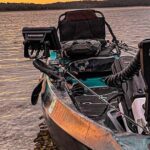Are you a wakeboarder looking to progress to the next level of tricks?
Or perhaps you’re a beginner looking to learn your first trick? Either way, you’ve come to the right place!
In this article, we’ll guide you through the world of wakeboarding trick progression. From beginner to pro, I’ll cover the different levels of tricks, proper techniques and safety tips for each, and even dive into some of the hardest tricks and techniques.
So grab your board and let’s get started!
Beginner Level Tricks
If you’re new to wakeboarding, it’s important to start with the basics. Beginner level tricks are a great way to build your foundation and gain confidence on the water.
These tricks are typically done on the flat water and involve basic jumps, spins, and surface tricks.
Some popular beginner level tricks include the basic jump, 180s, and surface tricks like the wake-to-wake and butter slide.
Before attempting any trick, it’s important to have proper technique and safety knowledge.
For example, when learning the basic jump, it’s crucial to keep your weight centered over the board and knees bent to absorb the landing impact.
And always remember to wear a life jacket and helmet for added safety. With practice and patience, you’ll be mastering these beginner level tricks in no time!
Intermediate Level Tricks
Once you’ve mastered the beginner level tricks, it’s time to progress to the intermediate level.
These tricks are more challenging and often involve spins, grabs, and even inverts (flipping upside down). Some popular intermediate level tricks include the backside 180, frontside 360, and the method grab.
As with any trick, it’s important to have proper technique and safety knowledge.
For example, when learning the backside 180, it’s important to use your shoulders and upper body to initiate the spin, while keeping your head and eyes focused on the landing.
And always remember to practice in a safe and controlled environment, with a spotter and safety boat nearby.
With practice and determination, you’ll be able to progress through the intermediate level tricks and onto more advanced maneuvers.
Advanced Level Tricks
Now it’s time to step up your game and tackle the advanced level tricks. These tricks involve complex spins, grabs, and inverts, often done off the wake.
Some popular advanced level tricks include the frontside 900, backside 540, and the crow mobe.
Advanced level tricks require not only proper technique and safety knowledge but also a high level of athleticism and bravery.
It’s important to only attempt these tricks when you feel confident and comfortable, and always under the guidance of a professional coach or experienced rider.
And as always, safety should be your top priority.
It’s worth noting that some of the hardest wakeboard tricks fall under the advanced level category, such as the double half-cab roll and the 1080 spin.
These tricks are not for the faint of heart and require years of practice and dedication to master.
Whether you’re aiming to master the advanced level tricks or simply looking to progress through the levels of tricks, the key is to stay committed and keep practicing.
The journey to becoming a skilled wakeboarder is a long and challenging one, but the rewards are well worth it.
What is the Hardest Wakeboard Trick?
drrrummm rrrollll 🙂
Its the Double Half-Cab Roll…
The hardest wakeboard trick is a matter of debate, as it can vary depending on a rider’s skill level and personal preferences.
However, there are a few tricks that are widely considered to be some of the most difficult and technical in the sport.
One of these tricks is the double half-cab roll, which involves two backflips with a 180-degree spin each, performed in quick succession. This trick requires a lot of height and speed, as well as a precise sense of timing and control.
Another difficult trick is the 1080-degree spin, which involves three full rotations in the air. This trick requires a lot of speed and pop off the wake, as well as a precise sense of timing and a strong sense of balance and control.
Other challenging tricks include the mobe 7, the crow mobe, and the double half-cab roll to blind. These tricks require a lot of skill and practice, as well as a willingness to push yourself to new heights.
Ultimately, the hardest wakeboard trick is the one that challenges you the most and pushes you beyond your comfort zone.
Whether it’s a basic trick or an advanced one, the key is to have fun, stay safe, and never stop learning and improving.
But please always keep your safety in mind.
What is the KGB Wakeboard Trick?
The KGB is a popular wakeboard trick that was made famous by professional wakeboarder Aaron Rathy.
This trick involves a backside 540-degree spin with a backside 180-degree grab, where the rider grabs the board between their bindings with their front hand.
The KGB is an advanced level trick that requires proper technique and timing. To attempt this trick, the rider must approach the wake with enough speed and pop off the wake using their back foot, while simultaneously initiating the spin and grab.
The rider then lands switch, which means riding backwards with the opposite foot forward.
Although challenging, the KGB is a crowd-pleaser and a great addition to any wakeboarder’s trick repertoire.
But as with any advanced level trick, it’s important to have proper safety equipment and training, and only attempt the trick when you feel confident and comfortable.
Wakeboard Cable Tricks
Wakeboarding isn’t just limited to being towed behind a boat. Cable wakeboarding is a growing discipline in the sport, where riders are pulled by cables over a series of obstacles such as rails, kickers, and sliders.
Cable wakeboarding offers a unique and creative way to perform tricks, with endless possibilities for innovation and style.
Some popular cable wakeboard tricks include the frontside boardslide, backside 270, and the frontside 360.
Cable parks are becoming more common and accessible, providing a fun and social environment for wakeboarders of all skill levels.
Cable wakeboarding is also a more environmentally friendly option compared to traditional boat wakeboarding, as it uses electric cables instead of gas-powered boats.
Whether you prefer boat wakeboarding or cable wakeboarding, the important thing is to have fun and stay safe while pushing yourself to new heights.
Wakeboard Air Tricks
Air tricks are a staple of wakeboarding, and involve getting airborne and performing tricks while in the air.
These tricks require a combination of technique, timing, and athleticism, and are often the most crowd-pleasing aspects of the sport.
Some popular wakeboard air tricks include the tantrum, the scarecrow, and the backroll. The tantrum involves a backflip with a frontside 180-degree spin, while the scarecrow is a front flip with a backside 180-degree spin.
The backroll is a basic trick that involves a backflip without any spin.
Air tricks require a lot of practice and confidence, and it’s important to start with basic tricks and gradually progress to more advanced ones.
Proper technique and timing are essential, as well as having a good sense of balance and control.
In addition to being impressive to watch, air tricks can also be a lot of fun to perform and offer a great sense of accomplishment when you land them successfully.
But always remember to prioritize safety and never attempt a trick that is beyond your skill level or comfort zone.
In conclusion
Wakeboarding is a dynamic and exciting sport that offers a wide range of tricks and techniques to master.
From basic jumps to complex spins and flips, there is always something new to learn and explore.
Whether you’re a beginner or an advanced rider, it’s important to practice good technique, prioritize safety, and never be afraid to push yourself to new heights.
By following a progressive trick list and gradually building your skills and confidence, you can become a skilled and accomplished wakeboarder.
And with enough dedication and practice, who knows – maybe you’ll be able to master the KGB or the 1080-degree spin someday.
So get out on the water, have fun, and enjoy all that wakeboarding has to offer!
FAQs
Here are some FAQs I get related to wakeboard trick progression:
Q: How do I know which wakeboard trick to learn next?
A: The best way to know which wakeboard trick to learn next is to follow a trick progression list, starting with the basic tricks and gradually working your way up to the more advanced ones. This will help you build your skills and confidence over time, and ensure that you have a solid foundation for more complex tricks.
Q: How long does it take to master wakeboarding tricks?
A: The amount of time it takes to master wakeboarding tricks depends on a variety of factors, including your skill level, the difficulty of the trick, and how often you practice. Some basic tricks can be learned in just a few sessions, while more advanced tricks can take months or even years to master.
Q: What is the hardest wakeboarding trick to learn?
A: The hardest wakeboarding trick to learn is a matter of debate and can vary depending on a rider’s skill level and personal preferences. However, some of the most difficult and technical tricks include the double half-cab roll, the 1080-degree spin, and the KGB.
Q: What is a cable wakeboard trick?
A: Cable wakeboarding involves riding a wakeboard on a cable system rather than being towed behind a boat. Cable wakeboard tricks can include jumps, spins, and grinds, and are typically performed on features like rails and kickers.
Q: What is an air trick in wakeboarding?
A: An air trick in wakeboarding is any trick that involves leaving the water and performing a maneuver in the air before landing back on the water. Air tricks can include jumps, spins, and flips, and are a fundamental part of wakeboarding.

